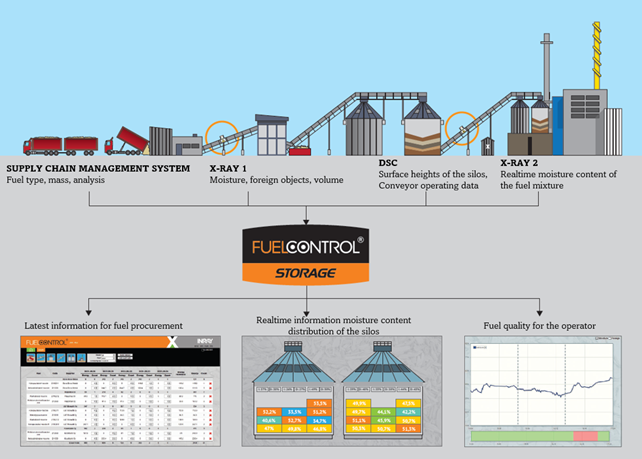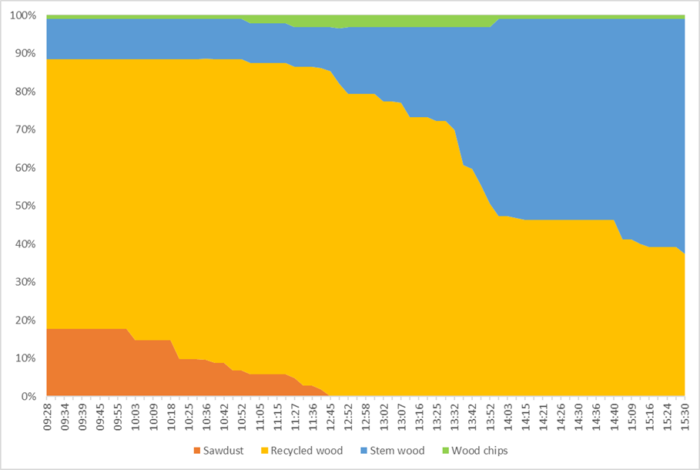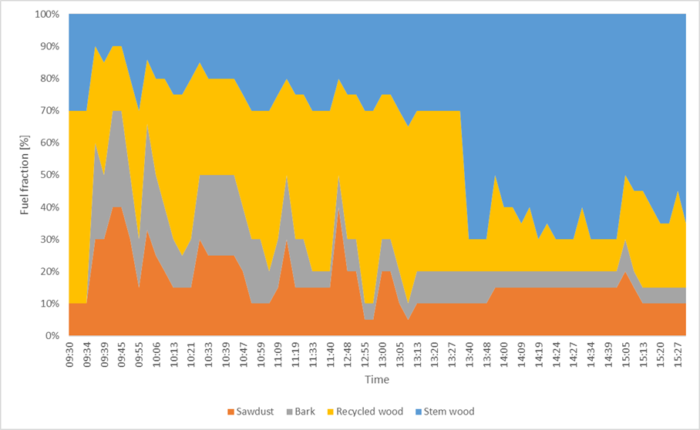FUELCONTROL ® Storage, developed by Inray Oy Ltd, is a real-time storage model for solid fuel management at biopower plants. The objective of the storage model is to provide operators and the automation system with real-time information on the moisture distribution and energy content of storage and boiler silos. The model can be used to prevent problems caused by variations in fuel quality and to facilitate control of the combustion process. The storage model has been developed since 2015 and is currently being demonstrated at Vantaan Energia’s Järvenpää power plant as part of the Business Finland-funded SmartFlex project, which involves VTT, Fortum Power and Heat Oy, Sumitomo SHI FW Energia Oy (SFW) and Pinja Oy, in addition to Inray.
The system compiles data into usable format
The system consists of a FUELCONTROL® scanner that measures moisture, the amount of foreign object and fuel volume at the fuel reception conveyor. The system saves the measurement and process data in a database, from which it can be monitored using a web-based interface. The machine vision system (Inray Camera) can also be added to the fuel reception to automatically identify different types of fuel. The silo modelling uses fuel load identification data, fuel X-ray and quantity measurements, elemental analyses, silo surface measurements and conveyor feed and discharge data. Data on minute level is transported through the model and the situation is always updated according to silo surface level data and feed and discharge data. The distribution of silos can be viewed by the following parameters: fuel type, moisture content, foreign object content, elemental content, and energy content.

The missing piece for operating a power plant
At the moment, power plants are operated without accurate information on the fuel. Less attention has been paid to the possibilities of optimization before the fuel is fed to the boiler. Fuel is still the largest unknown factor in the combustion process. After the fuel reception, fuels are routed to storage silos based on their surface height. Currently the only fuel data received from the storage silos are simply cubic meters and surface heights. At present, power plants do not have sufficiently accurate advance information on the moisture content of the fuel mixture or on the proportions of the different fuel fractions in the mixture that are being fed to the combustion. Measuring fuel at the fuel reception is not sufficiently accurate data to predict the quality parameters of the fuel mixture entering the boiler because storage will change the moisture content of fuels due to the mixing and the conditions.
Regarding boiler control, it is desirable to have information on fuel quality and quantity before the material is fed into the combustion chamber. At larger plants, problems arise when large quantities of inhomogeneous fuel enter the boiler, as the control of the adjustment values and combustion processes of the boiler becomes difficult, and emissions increase momentarily before returning to normal. The storage model can be used to detect quality variations before the fuel is fed into the boiler. With real-time quality information on the storage situation available to power plants, proactive measures can be taken even for poor quality fuels, reducing the additional costs. The boiler can also be operated closer to its limit values as more accurate fuel quality information is available.
Controlling the feeding and discharging of silos utilizing the storage model allows to improve the quality of the fuel fed into the boiler and to achieve the most homogenous fuel possible, thus optimizing the combustion process. In addition, the control enables the optimization of fuel mixtures. Optimization of the mixture ratios is a way to avoid adding expensive additives such as sulfur and sulfates to the boiler if there is a risk of chlorine-induced corrosion. In addition, the control allows the boiler to be protected by avoiding undesirable fuel mixtures that cause other harms in the boiler such as fouling, agglomeration of the sand bed and melting of the ash. The model helps to maintain boiler and turbine operation at a more optimal level, reducing emissions and improving combustion efficiency. In addition, the storage model can be utilized in fuel procurement, as the person in charge for the fuel procurement will have precise knowledge of the plant’s stock situation when placing orders.
Feedback of the fuel procurement
In the storage model, you can go back in time and review the fuel proportions in the silos, or the fuel mixture fed into the boiler and their contributions to the problem. When the possible cause is identified, the lessons learned can be used for implementing corrective actions to improve fuel supply. Systematic collection and analysis of fuel data is essential in identifying problems at the power plant more broadly. Statistical studies and connections between fuels and, for example, corrosion damages can be examined, and efforts can be made to avoid these unfavorable conditions in the future.
Demonstration at the Järvenpää plant

The system is currently demonstrated at the Järvenpää multi-fuel plant. Combined heat and power are produced in a BFB boiler of the CHP plant. The fuel power of the multi-fuel plant is 76 MW. It produces 23.3 MWe of electricity, the steam cycle produces 45 MW of district heat and the excess heat from the flue gas condenser produces 15 MW of extra district heat. The boiler can burn various different fuels with different physical characteristics and heat values. The fuel fractions used in the Järvenpää power plant include wood fuels, recycled wood, and recycled fuels. The annual fraction of wood fuels varies between 0 to 100 percent and the annual fraction of recycled fuels varies between 0 to 30 percent.
The plant has used Inray’s FUELCONTROL fuel quality measurement system for fuel reception since 2015. The system measures moisture content of each load recognizing foreign objects and this data is used to calculate the energy content of the loads for fuel pricing. For demonstration purposes, a second FUELCONTROL system was installed at the plant in August 2020 to measure the fuel flow to the boilers. The Inray Camera machine vision system was also installed in the fuel reception area to categorize fuel types. In addition, process data acquisition from the DCS and the fuel management system was organized at the plant.
One of the objectives of the demonstration is to verify the operation of the storage model which has been researched in Jenni Partti’s thesis. Three test runs periods were carried out at the power plant, during which the accuracy of the storage model in terms of real-time, fuel mixture composition and moisture was researched. Samples of the fuel flow from the storage silos were taken, analyzed, and compared to the storage model data. The accuracy of the storage model with the reference samples can be established from the sample graphs below. The first graph is the composition of the fuel mixture in the storage model as a function of time. The second graph below is the fuel composition of the reference samples as a function of time.


The storage model is the operator’s new partner
In future, the model can be further developed to optimize fuel mixtures, where risk levels for different elemental ratios and heavy metals can be determined, allowing the model to provide a set of possible fuel mixtures that meet these requirements. In addition, the optimization of sulfur feed to the boiler can be researched. The storage model can assist the boiler running process as it will detect a clear change in quality before the fuel is fed into the boiler. This change generates an alarm response, and the values are manually or automatically adjusted to keep the combustion process as efficient as possible. The storage model and smart boiler control systems can be utilized to support each other.
The article has also been published in Bioenergia magazine issue 4/2021.
